Abstract
To reveal the confinement mechanism of high-strength rectangular spiral stirrups (HRSSs) on fiber-reinforced concrete, this study designed and conducted axial compression tests on 20 HRSS-confined fiber-reinforced concrete columns. The effects of stirrup spacing, stirrup strength, and concrete strength on the strength and ductility of the columns were analyzed. The experimental results demonstrate that HRSS can significantly improve the performance of fiber-reinforced concrete. The peak strength of concrete exhibited a maximum increase of 2.033 times, and the ductility ratio achieved a maximum increase of 2.588 times. Furthermore, the application of densely spaced high-strength spiral hoops to confine the core concrete not only effectively enhances its compressive strength but also markedly improves its deformability. Based on the stress distribution across the cross-section of HRSS-confined fiber-reinforced concrete columns, this paper proposes a method for delineating the effective confinement area, establishes calculation models for effective lateral confinement stress, effective confinement coefficient, peak stress, and peak strain, and develops a stress-strain constitutive relationship suitable for HRSS-confined fiber-reinforced concrete columns.
1. Introduction
China is situated at the intersection of the Circum-Pacific Seismic Belt and the Eurasian Seismic Belt, characterized by frequent tectonic activities. From 2000 to 2017, 46 earthquakes of magnitude 6 or above occurred in mainland China [1]. According to data from the China Earthquake Networks Center, direct economic losses caused by earthquakes in China exceeded CNY 120 billion in 2023, with building collapses accounting for over 75% of casualties. Although traditional reinforced concrete (RC) structures exhibit high load-bearing capacity, their brittle failure modes—such as shear failure and crushing of joint cores—often lead to catastrophic consequences under strong seismic actions. The 2023 Turkey earthquakes further highlighted this vulnerability, where insufficient hoop confinement caused plastic hinge failure at column ends in numerous RC structures [2,3], underscoring the urgent need to enhance the strength and ductility of confined concrete in engineering practice.
To address these challenges and overcome the performance limitations of conventional confined concrete, the international research community has proposed two primary technical pathways: (1) High-strength confinement systems: High-strength hoops (yield strength > 600 MPa) improve lateral confinement capacity. Spiral hoop confinement replaces conventional hoops to optimize confinement effectiveness. Studies show spiral hoops generate significantly higher lateral confinement stress than standard hoops at equivalent reinforcement ratios due to their continuous configuration [4]. (2) Fiber-reinforced concrete: Steel or synthetic fibers enhance concrete’s ultimate tensile/compressive strains through crack-bridging effects [5,6], mitigating brittle failure tendencies. The synergistic application of high-strength confinement and fiber reinforcement establishes a multi-level seismic defense system: external hoop confinement coupled with internal fiber toughening. High-strength rectangular spiral stirrup (HRSS)-confined fiber-reinforced concrete—a novel composite material combining high-strength materials, spiral hoop confinement, and fiber reinforcement—has demonstrated substantial research value and application potential in modern complex structural design contexts.
High-strength stirrups can effectively confine concrete, a mechanism critical for enhancing the load-bearing capacity and deformation performance of concrete columns [7]. Internationally, research on confined concrete dates back to the 1920s. Researchers worldwide have conducted extensive axial compression tests on stirrup-confined concrete specimens to investigate the strength and deformation properties of confined concrete. Scott and Park (1982) [8] proposed a constitutive model for confined concrete based on experimental studies and synthesis of prior research. This model postulated that stirrups exert no confining effect on concrete prior to reaching its compressive strength. However, due to the assumption that rectangular stirrups provide limited confining capacity, the model exclusively addressed circular stirrup-confined concrete and omitted considerations for rectangular stirrup confinement mechanisms. Sheikh et al. (1982) [9,10] conducted axial compression tests on 27 circular columns confined with spiral hoops and circular hoops, pioneering the concept of “effective confined concrete area”. Based on these findings, they developed a stress-strain constitutive model for confined concrete, which systematically quantified the relationship between confinement effectiveness and mechanical performance. The introduction of the “effective confined concrete area” marked a paradigm shift in confinement theory. This groundbreaking concept provided a critical analytical framework for subsequent researchers. Mander et al. (1982) [11] conducted experimental investigations on axially compressed members to systematically study the stress-strain behavior of confined concrete. Through these tests, they developed analytical formulations for calculating the effective confinement coefficient corresponding to various confinement configurations (e.g., spiral/rectangular hoops). This framework enabled the determination of the effective confined area of concrete, ultimately establishing a generalized stress-strain constitutive model for confined concrete under compression. The proposed model quantitatively characterized how confinement mechanisms enhance both the peak stress and ultimate strain of concrete, providing a theoretical basis for modern seismic design codes. Cusson and Paultre (1995) [12] conducted axial compression tests on 51 high-strength concrete columns subjected to confinement. Based on the effective confinement index, they classified the confinement zones into low-, medium-, and high-confinement regions and unconfined areas. This hierarchical confinement classification introduced a pioneering framework for subsequent theoretical advancements in confined concrete mechanics. Aoyama (2006) [13] conducted axial compression tests on circular and square columns confined with diverse hoop configurations. Based on experimental observations of confinement effectiveness and failure modes, he developed a constitutive model for confined concrete that explicitly accounted for the synergistic effects of hoop geometry and confinement stiffness. In China, Yang et al. [14] systematically summarized the axial compression, eccentric compression, and seismic performance of high-strength stirrup-confined concrete, identifying material strength enhancement and quantification of confinement efficiency as critical directions for future development. Deng [15] focused on the compressive behavior of stirrup-confined ultra-high-performance concrete (UHPC) columns, analyzing the synergistic effects between steel fibers and stirrups. Yan [16] and Sun [17] conducted in-depth studies on the seismic performance of high-strength stirrup-confined concrete columns. Their research demonstrated that such columns exhibit superior seismic resistance, including effective deformation resistance and energy absorption under earthquake loading. Shen et al. [18] established a calculation formula for the peak stress of confined concrete based on the confinement effect coefficient and the Guo-Wang [19] five-parameter failure criterion, further exploring the mechanical behavior of high-strength stirrup-confined concrete under axial compression. Zheng et al. [20] revealed the effects of concrete strength, stirrup strength, and stirrup spacing on the confinement efficiency of circular spiral stirrups through axial compression tests.
However, current research on high-strength stirrup-confined concrete still exhibits several limitations. Existing studies [21,22,23,24] have yet to precisely define the boundary of the confined region or the internal stress distribution patterns. Research on the effective confinement coefficient also lacks sufficient accuracy. Furthermore, studies on how high-strength materials influence the constitutive relationships of confined concrete remain sparse, with a limited exploration into how material properties alter these relationships. In summary, to advance the theoretical framework of confined concrete and promote the practical application of high-strength stirrup-confined fiber-reinforced concrete in engineering, further detailed research on its mechanical properties and constitutive models is imperative.
This study will perform axial compression tests on 20 groups of HRSS-confined fiber-reinforced concrete columns. By integrating existing theoretical frameworks for confined concrete and experimental data, the research aims to investigate the confinement mechanisms of HRSS-confined fiber-reinforced concrete; propose a calculation formula for lateral confining stress in rectangular spiral stirrups; establish an effective confinement zone delineation method and peak parameter calculation method for HRSS-confined fiber-reinforced concrete; and develop a uniaxial compressive constitutive model for HRSS-confined fiber-reinforced concrete. The specific workflow is illustrated in Figure 1.
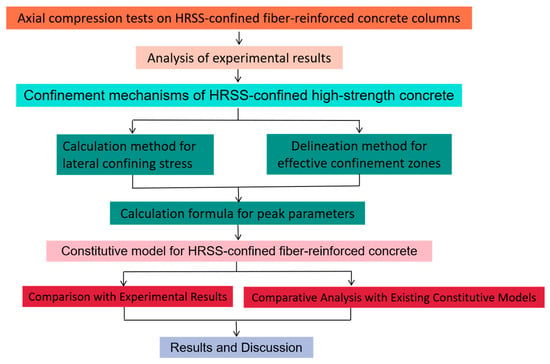
Figure 1.
Technical Roadmap.
2. Test Overview
2.1. Specimen Design
To investigate the confinement mechanism of HRSS-confined fiber-reinforced concrete in depth, this study designed 20 HRSS-confined fiber-reinforced concrete columns for axial compression tests. The experiments aimed to analyze the influence of factors including stirrup spacing, stirrup strength, concrete strength, and stirrup diameter on the mechanical performance of HRSS-confined fiber-reinforced concrete. The concrete cube compressive strength grades ranged from CL80 to CL110, and the yield strengths of the stirrups were 511 MPa, 612 MPa, and 691 MPa. The configuration of the stirrups is illustrated in Figure 2. Detailed design parameters are provided in Table 1.

Figure 2.
Stirrup type (a) square spiral stirrup; (b) rectangular spiral stirrup.

Table 1.
Design of specimen parameters.
2.2. Material Property Testing
2.2.1. Concrete
In the preparation of concrete, P.O 42.5R ordinary Portland cement, silica ash (enhance the density, strength, and durability of concrete), polycarboxylic acid high-performance water reducer, cement gypsum antifoam agent, 14 mm copper-coated steel fiber, and quartz sand were selected, as shown in Figure 3. Quartz sand includes 10–20 mesh, 20–40 mesh, 40–70 mesh, 70–120 mesh, and 325 mesh five particle sizes, the mass ratio of 1.1:0.6:1.5:1.3:1.4. The design mix ratio is shown in Table 2. The concrete used in this experiment was cast in three batches with strength grades of CL80, CL100, and CL110, respectively. For each batch, two groups of concrete cube specimens were prepared and cured using the water immersion method. The compressive strengths at 7-day and 28-day curing ages were tested prior to the experiment (see Table 3). The cube compressive strength (fcu) was calculated in accordance with the current Code for Design of Concrete Structures [25]. The axial compressive strength (fco) was derived using Equation (1):
where, αc1 is the ratio of prismatic compressive strength to cube compressive strength; αc2 is the reduction coefficient accounting for concrete brittleness. Both αc1 and αc2 are calculated according to the current code [25], with αc1 = 0.95 and αc2 = 0.8.
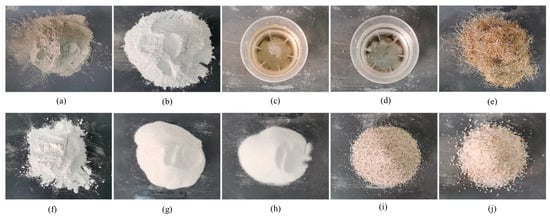
Figure 3.
Raw materials used in SFRC. (a) P.O 42.5R cement; (b) Silica fume; (c) Water reducing agent; (d) Defoamer; (e) Steel fiber; (f) 325 mesh quartz sand; (g) 70–140 mesh quartz sand; (h) 40–70 mesh quartz sand; (i) 20–40 mesh quartz sand; (j) 10–20 mesh quartz sand.

Table 2.
Concrete mix ratio.

Table 3.
Compressive strength of concrete cubes.
2.2.2. Steel Reinforcement
The longitudinal reinforcement in the specimens utilized HRB400-grade steel bars with a diameter of 16 mm. The mechanical properties of both the stirrups and longitudinal bars are detailed in Table 4, and the stress-strain curve of the stirrups is illustrated in Figure 4.

Table 4.
Mechanical properties of rebar.
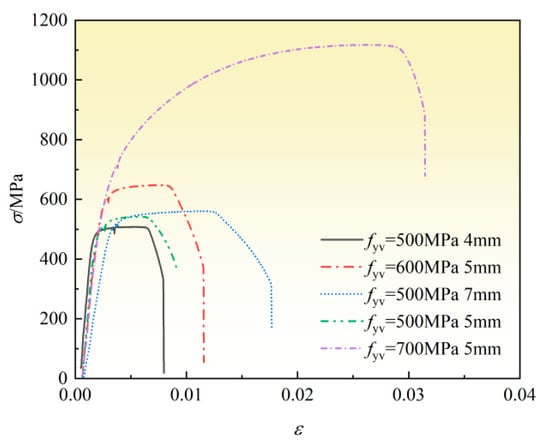
Figure 4.
Stress-strain curves of stirrup.
2.3. Test Setup and Loading Protocol
The experiments were conducted on a 5000 kN hydraulic testing machine at the Structural and Seismic Engineering Laboratory of Xi’an University of Architecture and Technology. The loading setup and schematic diagram are illustrated in Figure 5. During testing, load values and displacement measurements were automatically recorded using a TDS-602 (Sansel Instruments and Controls, Chennai, India) data acquisition system, which features high sampling frequency, precision, and multi-channel capabilities, ensuring real-time and accurate data collection for comprehensive and reliable results.
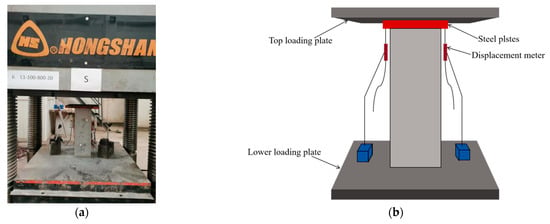
Figure 5.
Loading setup and its schematic diagram. (a) 5000 kN hydraulic testing machine; (b) schematic diagram of the loading setup.
The specimens were loaded under displacement-controlled mode. Prior to formal loading, geometric and physical alignment procedures were performed:
- (1)
- Geometric Alignment: The specimen was positioned to ensure its longitudinal axis coincided precisely with the loading direction;
- (2)
- Physical Alignment: Instrumentation (e.g., displacement transducers) was calibrated to eliminate initial measurement biases.
A constant loading rate of 0.2 mm/min was maintained until specimen failure. Throughout the process, the data acquisition system continuously recorded all parameters, providing a complete dataset for post-test analysis.
2.4. Test Observations
The testing process can be divided into four distinct stages.
- (1)
- Stage 1: Elastic Stage
The specimen exhibited linear elastic behavior with a nearly linear stress-strain relationship. Axial strain, stirrup strain, and surface concrete strain remained minimal, and the confining effect of the stirrups was not yet activated. As the load increased, fine vertical cracks initiated at the column corners. These cracks propagated slowly upward and downward due to the gradual exceedance of concrete’s tensile strength by internal tensile stresses (Figure 6a).
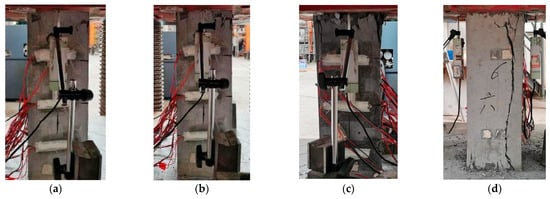
Figure 6.
Specimen loading diagram. (a) Stage 1; (b) Stage 2; (c) Stage 3; (d) Stage 4.
- (2)
- Stage 2: Yielding Stage
With continued loading, the specimen reached its yield state. Cracks multiplied, widened, and interconnected, forming a complex network on the column surface. Audible “cracking sounds” accompanied the spalling of the concrete cover, signaling microcrack coalescence and the transition from elastic to elastoplastic behavior (Figure 6b).
- (3)
- Stage 3: Peak Load and Cover Spalling
At peak load, the concrete cover spalled due to bond failure between the cover and core concrete under high stress. This resulted in a sharp drop in load-bearing capacity. However, high-strength stirrups (HRSSs) actively confined the core concrete, enabling it to sustain residual load (Figure 6c).
- (4)
- Stage 4: Post-Peak Ductility and Failure
When the load dropped to approximately 65% of the peak load, the decline stabilized temporarily. The stirrups’ lateral confinement enhanced the core concrete’s compressive strength and ductility by restricting transverse deformation. Eventually, cracks penetrated the entire column, leading to core concrete crushing, structural void expansion, and complete loss of load capacity (Figure 6d). The failure morphology highlighted the progressive damage mechanism of high-strength stirrup-confined fiber-reinforced concrete under axial compression.
2.5. Test Results
The test results are summarized in Table 5, where fcc and εcc represent the peak compressive strength and peak strain of the confined concrete, respectively; ε85 denotes the ultimate strain when the compressive strength drops to 85% of the peak value; ε65 is the strain corresponding to 65% of the peak strength. The strength enhancement ratio (fcc/fco) and ductility ratio (ε85/εcc) serve as key indicators for evaluating the strength and ductility of confined concrete. Key findings include the following:
- (1)
- HRSS Effectiveness: Specimen L-13 achieved a strength enhancement ratio of 2.033, while L-14 exhibited a ductility ratio of 2.588, demonstrating that HRSS significantly improves both peak strength and deformability by providing effective lateral confinement to fiber-reinforced concrete columns;
- (2)
- Impact of Stirrup Spacing: For specimens L-1, L-6, L-7, and L-8 (with identical parameters), smaller stirrup spacings resulted in higher strength enhancement ratios but lower ductility ratios;
- (3)
- Effect of Stirrup Diameter and Spacing: Specimens L-9, L-17, and L-18 (with equal volumetric stirrup ratios) showed that finer stirrups with closer spacing provided superior performance, yielding higher strength enhancement and ductility ratios;
- (4)
- Influence of Concrete Strength: Comparisons among specimens L-11, L-12, L-13; L-1, L-9, L-10; and L-14, L-15, L-16 revealed that higher concrete strength grades led to lower strength enhancement ratios, indicating an inverse relationship between base concrete strength and confinement effectiveness.

Table 5.
Test results.
Table 5.
Test results.
| Specimen Number | fcc/MPa | fco/MPa | εcc | ε65 | ε85 | fcc/fco | ε85/εcc |
|---|---|---|---|---|---|---|---|
| L-1 | 140.14 | 78.84 | 0.0063 | 0.0084 | 0.0076 | 1.777 | 1.199 |
| L-2 | 126.41 | 78.84 | 0.0118 | 0.0202 | 0.0136 | 1.663 | 1.153 |
| L-3 | 113.62 | 78.84 | 0.0091 | 0.0132 | 0.0102 | 1.441 | 1.124 |
| L-4 | 138.27 | 78.84 | 0.0077 | 0.0124 | 0.0105 | 1.754 | 1.360 |
| L-5 | 143.44 | 78.84 | 0.0078 | 0.0114 | 0.0100 | 1.614 | 1.277 |
| L-6 | 140.81 | 78.84 | 0.0082 | 0.0246 | 0.0091 | 1.786 | 1.109 |
| L-7 | 134.43 | 78.84 | 0.0062 | 0.0070 | 0.0059 | 1.705 | 1.212 |
| L-8 | 131.59 | 78.84 | 0.0049 | 0.0124 | 0.0081 | 1.669 | 1.300 |
| L-9 | 135.20 | 78.84 | 0.0057 | 0.0070 | 0.0089 | 1.715 | 1.555 |
| L-10 | 142.43 | 78.84 | 0.0067 | 0.0200 | 0.0130 | 1.807 | 1.945 |
| L-11 | 127.79 | 65.19 | 0.0053 | 0.0188 | 0.0086 | 1.960 | 1.629 |
| L-12 | 114.58 | 65.19 | 0.0077 | 0.0184 | 0.0093 | 1.758 | 1.210 |
| L-13 | 132.51 | 65.19 | 0.0092 | 0.0245 | 0.0118 | 2.033 | 1.278 |
| L-14 | 133.88 | 88.69 | 0.0080 | 0.0114 | 0.0207 | 1.510 | 2.588 |
| L-15 | 123.94 | 88.69 | 0.0074 | 0.0096 | 0.0084 | 1.397 | 1.141 |
| L-16 | 147.11 | 88.69 | 0.0065 | 0.0184 | 0.0082 | 1.659 | 1.259 |
| L-17 | 137.49 | 78.84 | 0.0071 | 0.0121 | 0.0090 | 1.744 | 1.265 |
| L-18 | 131.22 | 78.84 | 0.0056 | 0.0080 | 0.0065 | 1.664 | 1.165 |
| L-19 | 120.37 | 78.84 | 0.0066 | 0.0138 | 0.0092 | 1.527 | 1.401 |
| L-20 | 140.14 | 78.84 | 0.0142 | 0.0279 | 0.0166 | 1.778 | 1.167 |
2.6. Parametric Analysis
- (1)
- Cross-Section Aspect Ratio
As shown in Figure 7a, the peak stress decreases with an increasing aspect ratio (length-to-width ratio). For specimens with smaller aspect ratios, the stress drops rapidly after reaching the peak load. In contrast, specimens with larger aspect ratios exhibit a plateau phase after peak stress before rapid softening. This indicates that increasing the aspect ratio effectively mitigates the abrupt post-peak stress drop, enhancing the ductility of HRSS fiber-reinforced concrete columns.
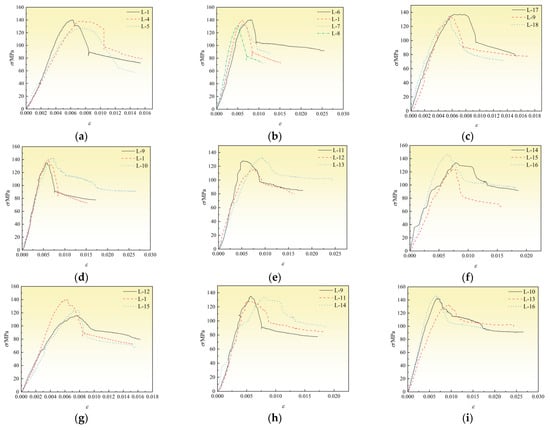
Figure 7.
Stress-strain curves of the specimens. (a) Different cross-section aspect ratios; (b) different stirrup spacings; (c) identical volumetric stirrup ratio with varying stirrup diameters; (d) CL100 Concrete; (e) CL80 Concrete; (f) CL110 Concrete; (g) 600 MPa-grade stirrups; (h) 500 MPa-grade stirrups; (i) 700 MPa-grade stirrups.
- (2)
- Stirrup Spacing
From Figure 7b,c, reducing the stirrup spacing increases both the peak stress and peak strain. This demonstrates that closely spaced, small-diameter, high-strength spiral stirrups effectively address the sharp post-peak stress decline, improving both strength and ductility by enhancing the confinement of the core concrete.
- (3)
- Stirrup Strength
As shown in Figure 7d–f, for CL100-grade concrete, the peak stress increases with higher stirrup strength. For CL80-grade and CL110-grade concrete, specimens with 600 MPa-grade stirrups exhibit the lowest peak stress, while those with 700 MPa-grade stirrups achieve the highest peak stress. Specimens with 500 MPa-grade stirrups show intermediate values. Notably, for CL80-grade concrete, the peak stresses of specimens with 500 MPa-grade and 700 MPa-grade stirrups are nearly identical. These show that low-strength concrete (CL80) exhibits insufficient lateral expansion to fully activate the confinement effect of medium-to-high-strength stirrups (600–700 MPa). Low-strength stirrups (500 MPa) are best suited for low-strength concrete (CL80) due to balanced deformation compatibility. Moreover, high-strength concrete (CL110) is overly brittle, limiting its ability to mobilize lateral confinement stresses from stirrups. High-strength stirrups (700 MPa) should pair with high-strength concrete (CL110) to maximize confinement effectiveness. Furthermore, the similar peak stresses between CL80 specimens with 500 MPa-grade and 700 MPa-grade stirrups suggest that excessive stirrup strength cannot compensate for the limited lateral deformation capacity of low-strength concrete, resulting in underutilized confinement.
- (4)
- Concrete Strength
As shown in Figure 7d–f, for 500 MPa-grade and 700 MPa-grade stirrups, peak stress increases with concrete strength. The sensitivity to concrete strength is higher for 700 MPa-grade stirrups. For 600 MPa-grade stirrups, the highest peak stress occurs in CL100-grade concrete, followed by CL110 and CL80. This suggests that 600 MPa-grade stirrups are optimally compatible with CL100-grade concrete, likely due to balanced lateral deformation and confinement stress development. These observations further validate the Material Compatibility Principle: Low-strength concrete (≤CL80) should be paired with low-strength stirrups, while high-strength concrete (≥CL110) requires high-strength stirrups to achieve optimal synergistic effects. When the strength disparity between concrete and stirrups is excessive, the passive confinement effectiveness is compromised due to insufficient lateral expansion in high-strength concrete (caused by brittleness) or inadequate plastic deformation capacity in low-strength concrete.
3. Theoretical Analysis
3.1. Lateral Confinement Stress
When concrete expands under compressive forces, the stirrups generate tensile forces in the horizontal direction to resist the lateral deformation of the concrete. Simultaneously, the concrete develops a corresponding confinement force due to the restraint provided by the stirrups. The product of the tensile strength of the stirrups and their cross-sectional area is equal to the product of the lateral confinement stress of the concrete and its cross-sectional area. The lateral confinement stress for ordinary rectangular stirrup-confined concrete is calculated as shown in Equation (2) [11]:
where, n = number of stirrup legs within one stirrup spacing, fyv = yield strength of the stirrups, fl = lateral confinement stress acting on the concrete, Asp = cross-sectional area of a single stirrup leg, s = center-to-center spacing of the stirrups, and a = width of the confined concrete region, as illustrated in Figure 8.
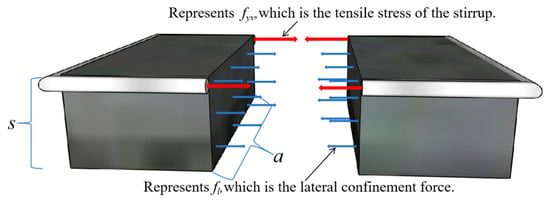
Figure 8.
Internal force equilibrium diagram for ordinary stirrup-confined concrete.
For spiral stirrup-confined concrete, the internal tensile force generated by the spiral stirrups in the horizontal direction is equal in magnitude to the lateral confinement force exerted on the concrete. The product of the horizontal tensile stress in the spiral stirrups and their cross-sectional area equals the product of the lateral confinement stress and the cross-sectional area of the concrete, as shown in Equation (3). The force equilibrium within any stirrup spacing interval is illustrated in Figure 9.
where, f1 = lateral confinement stress exerted by the spiral stirrups in the horizontal direction, and cross-sectional area of a single spiral stirrup.

Figure 9.
Internal force equilibrium diagram for spiral stirrup-confined concrete.
Due to the inclination angle between the spiral stirrups and the horizontal plane, the maximum stress provided internally by the stirrups is no longer solely their tensile strength. Both the axial stress and tangential stress of the stirrups contribute to the horizontal confinement force. Therefore, the magnitude of the maximum horizontal stress f1 provided by the stirrups is determined by the sum of the horizontal components of the axial and tangential stresses in the stirrups, as shown in Figure 10.
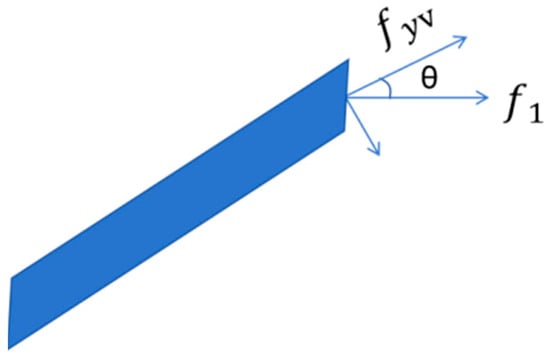
Figure 10.
Stirrup stress decomposition diagram.
Therefore, the formula to calculate the maximum horizontal stress provided by the stirrups is , where the cross-sectional area of a single stirrup is . Consequently, the lateral confinement stress for rectangular spiral stirrup-confined concrete is expressed by Equation (4):
3.2. Effective Confinement Zone (Ae) and Coefficient (ke)
Research indicates [10] that when circular stirrups confine concrete, the passive confinement pressure provided by the stirrups is uniformly distributed around the circumference. In contrast, for rectangular stirrups, the passive confinement pressure is non-uniformly distributed, with the maximum pressure concentrated at the intersection points between stirrups and longitudinal bars. Away from these intersections, the lateral confinement effect diminishes rapidly. This occurs because of high axial stiffness at intersections: At stirrup-longitudinal bar intersections, the axial stiffness of the stirrups is high, resulting in minimal deformation under transverse concrete expansion, thereby enhancing confinement effectiveness; Reduced stiffness away from intersections. Away from intersections, the axial stiffness decreases, and the flexural rigidity of the stirrups dominates. Larger deformations under transverse expansion weaken the confinement effect. Similarly, along the longitudinal direction, the confinement effect is strongest at stirrup-longitudinal bar intersections and weaker elsewhere. Thus, the lateral confinement force of stirrups is only effective within the core concrete region subjected to active restraint, as illustrated in Figure 11.

Figure 11.
Effectively confined core concrete region.
Mander [11] proposed that the area of the non-effectively confined region is bounded by a standard parabola, where the base length Wi (i.e., the transverse spacing between adjacent longitudinal bars) is four times the height h of the parabolic arch. Based on the actual stress-strain curves of specimens L-1, L-2, and L-3 (Figure 12), it is observed that larger Wi results in smaller peak stress, indicating reduced effective confinement and a larger non-effectively confined area. Consequently, for HRSS-confined fiber-reinforced concrete, the height h of the parabolic arch in the non-effectively confined region increases with Wi. Assuming a proportional relationship between h/Wi and Wi, i.e., , it follows that , where k1 is a constant to be determined. Thus, the area of the non-effectively confined region in HRSS-confined fiber-reinforced concrete is calculated as shown in Equation (6):
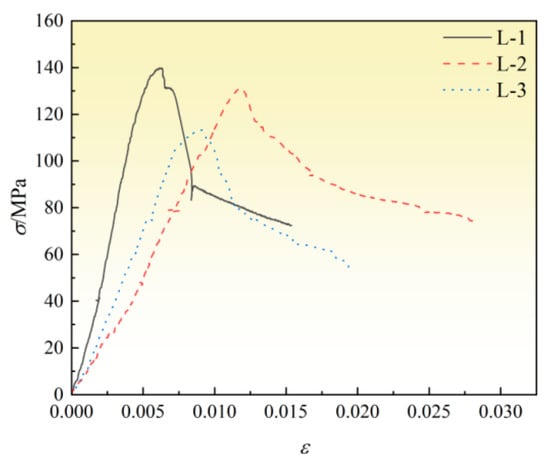
Figure 12.
Stress-strain curves of specimens with varying confined edge lengths.
For ordinary stirrup-confined rectangular concrete, the effectively confined area Ae is calculated by Equation (7), which accounts for the unconfined longitudinal regions and their relationship with stirrup spacing s. The first term of Equation (7) reflects the transverse confinement effect of the stirrups, while the second term represents the longitudinal confinement effect. For spiral stirrup-confined concrete, the longitudinal confinement is significantly enhanced due to the continuous helical reinforcement. Therefore, the value of the second term in the formula for the effectively confined area should be increased. The modified formula for spiral stirrup-confined concrete is defined in Equation (8), where k2 is a constant greater than 0 and less than 1/2:
The effective confinement coefficient ke is defined as the ratio of the effectively confined area to the difference between the cross-sectional area of concrete enclosed by stirrups and the total cross-sectional area of longitudinal reinforcement. Its calculation formula is given in Equation (9):
where, A = cross-sectional area of the core region enclosed by stirrups, and As = total cross-sectional area of all longitudinal reinforcement in the section.
3.3. Peak Parameters
3.3.1. Peak Parameters for Square Cross-Section Columns
Compared with plain concrete, confined concrete exhibits enhanced peak stress and peak strain, primarily due to the passive confinement provided by stirrups. The effectiveness of confinement is directly quantified by the lateral confinement stress. Therefore, the peak stress and peak strain of confined concrete can be expressed by Equations (10) and (11):
where, , , , and are constants to be determined, and fle represents the effective lateral confinement stress.
Through regression analysis of experimental data (excluding rectangular cross-section specimens L-4 and L-5) for Equations (10) and (11), the following coefficients are derived: k1 = 0.002, k2 = 0.3, = 2.817, = 0.418, = 6.043, = 0.253. The formulas for the peak parameters, non-effectively confined lateral area, and effectively confined area of HRSS-confined fiber-reinforced concrete are as follows:
By applying the aforementioned calculation formulas, the theoretical values of the peak stress enhancement ratio (fcc/fco)c and peak strain enhancement ratio (εcc/εco)c for HRSS-confined fiber-reinforced concrete can be obtained, as illustrated in Figure 11. In the figure, (fcc/fco)e and (εcc/εco)e represent the experimental values of these enhancement ratios. As shown in Figure 13, the calculated enhancement ratios for both peak stress and peak strain exhibit good agreement with the experimental results, validating the accuracy of the theoretical model.
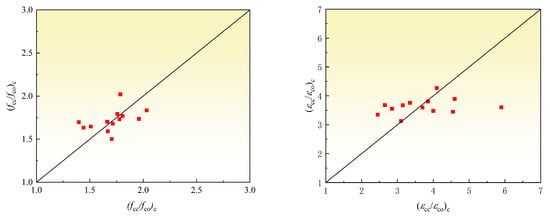
Figure 13.
Comparison of theoretical and experimental peak parameter enhancement ratios.
3.3.2. Peak Parameters for Rectangular Cross-Sections
For HRSS-confined fiber-reinforced concrete with rectangular cross-sections, the lateral confinement stresses differ along the width (x-direction) and length (y-direction). Therefore, the calculation method for peak parameters requires further refinement. Assuming the lateral confinement stress along the width (x-direction) is flx and along the length (y-direction) is fly, their formulas can be derived from Equation (3), as shown in Equations (17) and (18):
For effectively confined area and effective confinement coefficient, the calculation methods are identical for both square and rectangular confined concrete. Therefore, the formulas for the effective lateral confinement stress of HRSS-confined fiber-reinforced concrete are expressed as Equations (19) and (20):
where, n1 = number of stirrup legs along the x-direction within one stirrup spacing, n2 = number of stirrup legs along the y-direction within one stirrup spacing, flxe = effective lateral confinement stress along the x-direction of the cross-section, and flye = effective lateral confinement stress along the y-direction of the cross-section. For ordinary rectangular spiral stirrup-confined concrete, the effective lateral confinement stresses differ in the x- and y-directions. Therefore, calculating the peak parameters requires comprehensive consideration of flxe, flxe, and their coupling effects. The formulas for peak stress and peak strain are given in Equations (21) and (22):
Regression analysis of the experimental data for all specimens yields the following coefficients: = 0.371, = 0.428, = 0.201, = 0.209, = 0.321, = 0.470. Therefore, the calculation formulas for peak parameters of HRSS-confined fiber-reinforced concrete in general rectangular sections are given in Equations (23) and (24):
4. Stress-Strain Constitutive Model
Building on experimental results, this study proposes a complete stress-strain curve for HRSS-confined fiber-reinforced concrete. The ascending branch adopts the Popovics [26] model, while the descending branch follows the Fafitis and Shah [27] model; the descending branch passes through the point where the concrete strength drops to 65% of the peak strength. The full stress-strain curve is expressed as Equation (25):
where, the values of fcc and εcc are calculated using Equations (23) and (24) (Equations (15) and (16) for square columns), fc and εc = current stress and strain of the confined concrete, Ec = elastic modulus of concrete, and r = coefficient controlling the initial stiffness and ascending branch shape. A larger r indicates that the ascending branch approaches a straight line with a higher elastic modulus, calculated by Equation (26). k1 and k2 = coefficients governing the descending branch. For highly confined concrete, the larger values of k1 and k2 result in a smooth, convex-shaped descending branch of the stress-strain curve. Conversely, for lightly confined concrete, the smaller values of k1 and k2 lead to a steep, concave-shaped descending branch. k1 and k2 are calculated using Equations (27) and (28), respectively.
where, ε65 = strain corresponding to the point where the confined concrete strength drops to 65% of the peak strength. Figure 14 shows the relationship between ε65 and ρwεcc, where ρw is the area-based stirrup ratio (ratio of stirrup area to confined concrete area). Through regression analysis, the formula for ε65 is derived as Equation (29):
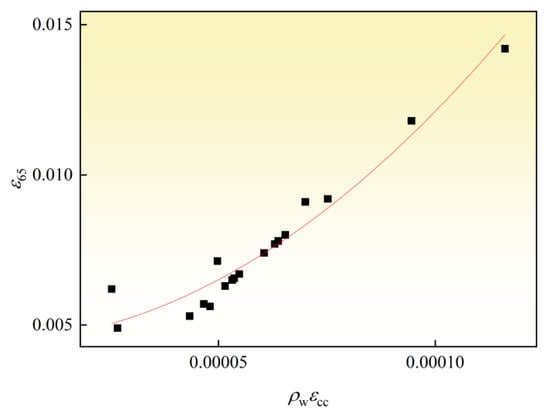
Figure 14.
The relationship diagram between ε65 and ρwεcc.
Figure 15 illustrates the relationship between the coefficient k2 and the effective confinement index fle/fco. Based on this, the formula for calculating k2 was derived through regression analysis and is given in Equation (28). The unknown coefficient k2 was determined by developing a MATLAB 2024av24.1 program and performing computational iterations. The core methodology involved minimizing the area difference between the stress-strain curves calculated from the proposed constitutive model and the corresponding experimental curves for all specimens.
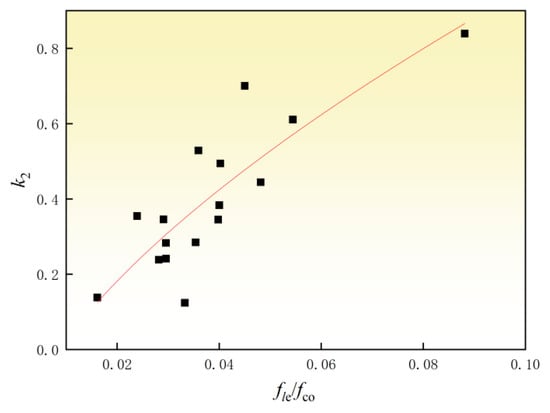
Figure 15.
The relationship diagram between k2 and fle/fco.
Several representative specimens were selected from the experimental tests. The stress-strain curves of these specimens were calculated using three models: the proposed model in this study (Proposed), the Mander [11] model, and the Cusson [12] model. The results were then compared against the experimental curves, as shown in Figure 16.
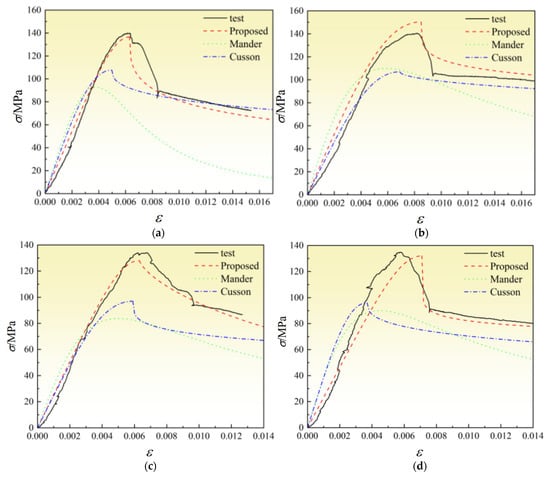
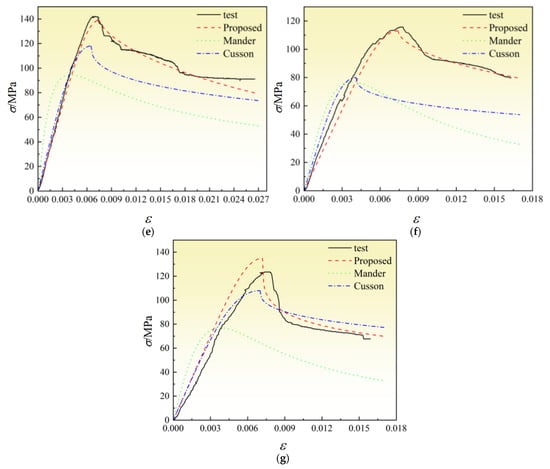
Figure 16.
Comparative diagram of complete stress-strain curves [11,12]. (a) L-1; (b) L-6; (c) L-8; (d) L-9; (e) L-10; (f) L-12; (g) L-15.
From the figures, it is evident that the complete stress-strain curve model for HRSS fiber-reinforced concrete proposed in this study aligns well with experimental results. Both the full-range stress-strain curves and the predictions of peak stress and peak strain are accurate. In contrast, the Mander [11] model and Cusson [12] model underestimate the peak stress and peak strain compared with actual test data primarily because they do not account for the enhanced confinement capability of spiral stirrups on core concrete. Furthermore, for specimens with small stirrup spacing (high confinement), the proposed model slightly overestimates peak stress; For specimens with large stirrup spacing (low confinement), the model underestimates peak stress (Figure 16a–c). The model performs less accurately for specimens with low stirrup strength (Figure 16a,d,e), showing deviations in the full stress-strain curve predictions. For ultra-high-strength concrete specimens, the model overestimates peak stress (Figure 16a,f,g).
5. Conclusions
Based on axial compression tests and theoretical analyses of 20 HRSS fiber-reinforced concrete columns, this study draws the following conclusions:
- (1)
- Superiority of Spiral Stirrups:
Experimental results indicate that HRSS-confined fiber-reinforced concrete exhibits an average peak strength enhancement factor of 1.70 and an average ductility ratio of 1.37. This improvement is attributed to the high-strength, continuous, and closed configuration of spiral stirrups, which provide uniform and sustained lateral confinement to the concrete columns. Such confinement effectively suppresses the lateral expansion of concrete under axial compression, significantly enhancing both compressive strength and load-bearing capacity. Compared with conventional hoops, spiral stirrups deliver more comprehensive and stable confinement effects, demonstrating superior performance in seismic design applications.
- (2)
- Enhanced Confinement with Small-Diameter, Closely Spaced Stirrups:
Analysis of specimens L-9, L-17, and L-18 reveals that under identical conditions (including equivalent volumetric stirrup ratios), smaller-diameter stirrups yield higher peak stresses. For instance, the peak stress of specimen L-17 is 1.05 times that of L-18, and L-17 exhibits gradual post-peak stress degradation rather than abrupt failure. This demonstrates that small-diameter, closely spaced, high-strength spiral stirrups provide more effective confinement. They not only enhance load-bearing capacity but also mitigate sudden stress drops after peak strength. When internal concrete damage initiates, these stirrups rapidly activate to restrain crack propagation and prevent concrete crushing, substantially improving the specimen’s overall bearing capacity and ductility.
- (3)
- Material Compatibility Principles:
The combination of low-strength stirrups with low-strength concrete effectively avoids premature failure caused by excessive material strength mismatch. Their synergistic interaction ensures stability during loading, as evidenced by specimen L-11 achieving 11.5% higher peak stress than L-12 (which used higher-strength stirrups). Conversely, pairing high-strength stirrups with high-strength concrete fully leverages their material advantages, providing robust confinement under heavy loads to ensure structural safety and stability (e.g., specimen L-16 reached a peak stress of 147.11 MPa). These findings underscore that rational material matching is critical for optimizing concrete structural performance and safety.
- (4)
- Proposed Constitutive Model:
This study introduced a refined confinement zone classification for spiral stirrup-confined concrete, establishing calculation methods for the effectively confined area and confinement coefficient. A constitutive model tailored for high-strength stirrup-confined high-strength concrete is proposed. Comparative analysis with experimental results and other constitutive models revealed that the proposed model more accurately reflects actual stress-strain curves and demonstrates close agreement with real mechanical behavior but exhibits deviations in predicting ultra-high-strength concrete.
Author Contributions
Conceptualization, P.F. and H.Z.; Methodology, P.F. and W.L.; Validation, P.F.; Formal analysis, P.F.; Investigation, P.F. and W.L.; Resources, H.Z.; Writing—original draft, P.F.; Writing—review & editing, P.F. and H.Z.; Supervision, H.Z.; Project administration, H.Z.; Funding acquisition, H.Z. All authors have read and agreed to the published version of the manuscript.
Funding
This research was funded by the Youth Fund of the National Natural Science Foundation of China (grant no. 52208202).
Data Availability Statement
The original contributions presented in this study are included in the article. Further inquiries can be directed to the corresponding authors.
Conflicts of Interest
The authors declare no conflict of interest.
References
- Yang, M.-Z.; Ma, H.-Q.; Luo, G.-F.; Xu, X.-Q. Research on the seismic strain field before strong earthquakes above M6 in Chinese mainland. Chin. J. Geophys. 2017, 60, 3804–3814. (In Chinese) [Google Scholar]
- Sezen, H.; Goksu, C. Failure Mechanisms of RC Columns in the 2023 Türkiye Earthquakes: Role of Hoop Confinement. Eng. Struct. 2023, 1, 141–296. [Google Scholar]
- Vuran, E.; Serhatoğlu, C.; Timurağaoğlu, M.Ö.; Smyrou, E. Collapse of RC Buildings in the 2023 Türkiye Earthquakes: Lessons from Plastic Hinge Detailing. J. Earthq. Eng. 2023, Accepted.
- Aoyama, H.; Noguchi, T. Seismic Performance of RC Columns with High-Strength Spiral Stirrups. J. Adv. Concr. Technol. 2015, 13, 437–448. [Google Scholar]
- Naaman, A.E.; Reinhardt, H.W. High-Performance Fiber-Reinforced Cement Composites: A Review. Cem. Concr. Res. 2003, 33, 853–859. [Google Scholar]
- Xu, S.; Li, Q. Mechanical Properties of Polypropylene Fiber-Reinforced Concrete. Constr. Build. Mater. 2018, 18, 342–350. [Google Scholar]
- Shi, Q.; Kun, Y.; Bai, L.; Zhang, X.; Jiang, W. Experiments on seismic behavior of high-strength concrete columns confined with high-strength stirrups. China Civ. Eng. J. 2011, 44, 9–17. (In Chinese) [Google Scholar]
- Scott, B.D.; Park, R.; Priestley, M.J.N. Stress-strain Behavior of Concrete Confined by Overlapping Hoops at Low and High Strain Rates. ACI J. 1982, 79, 13–27. [Google Scholar]
- Sheikh, S.A.; Toklucu, M.T. Reinforced concrete columns confined by circular spirals and hoops. ACI Struct. J. 1993, 9, 542–553. [Google Scholar]
- Sheikh, S.A.; Uzumeri, S.M. Analytical model for concrete confinement in tied columns. J. Struct. Div. 1982, 108, 2703–2722. [Google Scholar] [CrossRef]
- Mander, J.B.; Priestley, M.J.N.; Park, R. Theoretical stress strain model for confined concrete. J. Struct. Eng. 1988, 114, 1804–1826. [Google Scholar] [CrossRef]
- Cusson, D.; Paultre, P. Stress-strain model for confined high-strength concrete. J. Struct. Eng. 1995, 121, 468–477. [Google Scholar] [CrossRef]
- Aoyama, H. Modern High-Rise Reinforced Concrete Structural Design; Chongqing University Press: Chongqing, China, 2006. [Google Scholar]
- Yang, K.; Shi, Q.; Zhao, J.; Guo, Y. Axial Compression Performance of High-Strength Concrete Columns Confined by High-Strength Stirrups. Ind. Constr. 2013, 43, 9–13, 28. [Google Scholar]
- Deng, Z.-C.; Yao, J.-S. Research Progress on Compressive Behavior of Stirrup-confined Ultra-high Performance Concrete Columns. J. Archit. Civ. Eng. 2020, 37, 14–25. [Google Scholar]
- Yan, S.; Xiao, X.; Zhang, Y.; Kan, L. Seismic Performances of Square HSC Columns Confined with High-Strength PC Rebar. J. Shenyang Jianzhu Univ. 2006, 22, 7–10. [Google Scholar]
- Sun, Z.; Si, B.; Wang, D.; Guo, X.; Yu, D.H. Research on the seismic performance of high-strength concrete columns with high-strength stirrups. Eng. Mech. 2010, 27, 128–136. [Google Scholar]
- Shen, H.; Zhang, X.; Wei, H.; Jiang, Y.; Huang, W. Study on mechanical behavior of high strength stirrup confined concrete under axial compression. Build. Sci. 2024, 40, 151–159. [Google Scholar]
- Guo, Z.; Wang, C. Investigation of strength and failure criterion of concrete under multi-axial stresses. China Civ. Eng. J. 1991, 24, 1–14. [Google Scholar]
- Zheng, W.; Zhang, J.; Wang, G.; Wang, Y. Experimental study on axial compression behavior of high-strength concrete columns confined by spiral stirrups. China J. Highw. Transp. 2022, 35, 22–35. [Google Scholar]
- Jesus, M.; Lobo, P.S. Accuracy of models of confined concrete in rectangular columns using different proposals for the prediction of failure of the FRP. Procedia Struct. Integr. 2022, 1, 2452–3216. [Google Scholar] [CrossRef]
- Guo, S.; Zheng, D.; Zhao, L.; Lu, Q.; Liu, X. Mechanical test and constitutive model of recycled plastic fiber reinforced recycled concrete. Constr. Build. Mater. 2022, 19, 128578. [Google Scholar] [CrossRef]
- Zheng, B.T.; Teng, J.G. A plasticity constitutive model for concrete under multiaxial compression. Eng. Struct. 2022, 15, 0141–0296. [Google Scholar] [CrossRef]
- Bai, Z.; Liu, Y.; Yang, J.; He, S. A constitutive model for concrete subjected to extreme dynamic loadings. Int. J. Impact Eng. 2020, 183, 103483. [Google Scholar] [CrossRef]
- GB 50010-2002; Code for Design of Concrete Structures. China Architecture & Building Press: Beijing, China, 2002; pp. 5–6. (In Chinese)
- Popovics, S. A numerical approach to the complete stress strain curve of concrete. Cem. Concr. Res. 1973, 3, 583–599. [Google Scholar] [CrossRef]
- Fatifis, A.; Shah, S.P. Lateral reinforcement for high-strength concrete columns. ACI Spec. Publ. 1985, 87, 213–232. [Google Scholar]
Disclaimer/Publisher’s Note: The statements, opinions and data contained in all publications are solely those of the individual author(s) and contributor(s) and not of MDPI and/or the editor(s). MDPI and/or the editor(s) disclaim responsibility for any injury to people or property resulting from any ideas, methods, instructions or products referred to in the content. |
© 2025 by the authors. Licensee MDPI, Basel, Switzerland. This article is an open access article distributed under the terms and conditions of the Creative Commons Attribution (CC BY) license (https://creativecommons.org/licenses/by/4.0/).